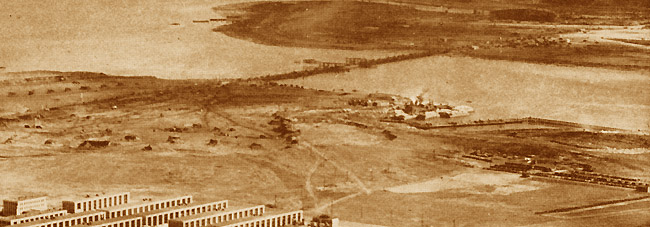| As these three sections of an aerial photo in a 1941 DOC report show, more than ample acreage remained available for pig pens and other farming structures after the opening of the Penitentiary complex in 1935.
The barn and coops near the lower right corner of the image spread across the very top of this page are the same ones seen, albeit from a different perspective and closer range, in the top-of-the-page image of Page 2 of this presentation.
Farm Title Goes, Farming Continues
Of course, the opening of Penitentiary and Hospital ended Rikers Island being designated in the departmental directory listings as the Municipal Farm, but farming continued on the island without that formal designation.
XXX
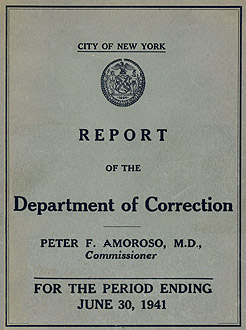
XXX
|
|
Cover of 1941 DOC report.
|
| As Correction Commissioner Peter F. Amoroso wrote on Page 70 in his 1941 report:
"A 100-acre farm. operated by 50 inmates under supervision of skilled farm instructor raises a variety of vegetables.
"A piggery, with 700 swine, produces 110,000 pounds of pork annually. A greenhouse is now in use."
On Page 26, the commissioner cited the DOC farms on Rikers and Hart Islands in NYC and at New Hampton, Orange County and declared "Expansion of all farms has been provided for." On the same page, he also reported:
"A [tree] nursery has been established at Rikers Island to supply stock for the City parks. The work is done by inmate labor under the direction of the Parks Department headed by Commissioner Robert Moses."
Amoroso, who had a keen interest in history, took a portion of Page 68 to sketch in short phrases the island's DOC story:
"HISTORY: Original land 87 acres in extent. Increased to 400 acres by dumping ashes and other wastes. Present buildings [Penitentiary, Workhouse, Hospital] largely on original land but piling under foundations necessary in some places. Slight settlement has occurred but now apparently stopped.
XXX
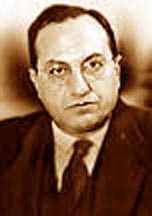
XXX
|
|
Commissioner Peter F. Amoroso 10/16/40
-- 12/27/46
|
| "Dumping by the Department of Sanitation stopped in vicinity of the institution and dumps are landscaped by Department of Parks in preparation for World's Fair. When broken down, dumps make tillable farm land.
"Island formerly called Municipal Farms: 150 - 400 prisoners in wooded barracks. Construction of penitentiary started in January 1931. Prisoners (145) transferred from Welfare island Penitentiary in June 1935. Census reached 1700 when last prisoner transferred from Welfare Island Penitentiary in February 1936. Hospital opened in March 1936. Last prisoner transferred from [Welfare Island] Correction Hospital (Workhouse) in October 1936.
"Institution now completed: all furnishings and equipment received. Present census over 2500."
Four years later the farm expansion that the commissioner had mentioned in his 1941 report evidentially was still taking place. This is indicated by an interesting paragraph under the heading Bureau of Engineering and Maintenance on Page 25 of Amoroso's 1945 annual report.
"The types of jobs completed involved electrical, plumbing, carpentry, iron work, boiler, locks etc. as well as the construction of the Protestant Chapel and Mission House and the erection of large chicken houses."
Add Acres for Agriculture
Amoroso's successor as Correction Commissioner, Albert Williams, declared on Page 32 of his 5-year report (Dec.26 , 1946 to Dec. 31, 1951) that "The {Rikers] hennery was extended, grounds graded and a modern slaughter house installed."
Williams also discussed on Page 42 and Page 66 the details of land reclamation on the island:
XXX

XXX
|
|
Commissioner Albert Williams 12/27/46
-- 12/31/53
|
| "An extensive land reclamation project is now under way on Rikers Island, which was made possible with the removal of the department of Sanitation dumping plant, formerly used for disposal of waste materials from City-wide collections.
"High hills of refuse are in the process of being razed and extensive holes filled in. In order to accomplish this 25 dump trucks which were relinquished by various City Departments . . . .
"When this project is completed, there will be additional acreage for farm activities. Five new area will be assigned for this purpose, thus expanding the farm to 137 acres .
"The tree nursery operated by the Department of Parks with inmate labor will be expanded threefold to 69 acres . . .""
The first of Anna M. Kross more than a dozen reports – 1953 – devoted all of Page 43 to "The Rikers Island Tree and Nursery Project:"
"This cooperative venture between the Department of Correction and the Department of Parks, dating back about 15 years, is a most productive program from both a financial and occupational therapeutic point of view.
"During the year 5,010 tree and 15,500 scrubs were removed from the Nursery for shipment and transplanting. . . .
"Estimated and Approximate Valuation: $106,450.00.
XXX
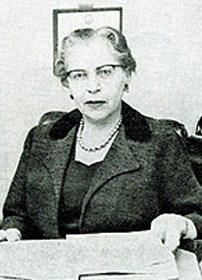
XXX
|
|
From front cover of the 1954 annual report of the NYC Dept. of Correction -- Anna M. Kross' second report as its commissioner.
|
| "No recovery credit is given the Department of Correction for the services rendered to other municipal departments.
"An average of 200 alcoholic and sentenced narcotic addicts are assigned in separate groups and work gangs, to maintain this gainful activity.
"To direct the technical tree-planting phase of the project several Department of Parks’ employees are assigned and they are accompanied by our custodial personnel for the supervision of the inmates.
"The physical health of the men shows marked improvement here, with individual gains of 25 to 35 lbs. In weight after a period of time in this active outdoor work. "The opportunity to learn a gainful vocational activity is evident, for those so inclined, as there are definite opportunities of employment on release in this field of endeavor."
On Page 14 she noted that:
"The Land Reclamation Project continues on the south end of Rikers Island, and additional acreage of productive land is steadily being added to the institutional farm area and that section used by the Department of Correction and Department of Parks’ Tree Nursery Project."
Poultry Project's Rise & Fall
Page 41 of AMK’s 1953 report included "Farming" statistics for DOC’s Rikers and New Hampton farms. The island was credited with 3,887 dozen eggs; 13,945 pounds of poultry from chicks; 52,193 pounds of vegetables produced; 115 tons of fertilizer produced.
XXX
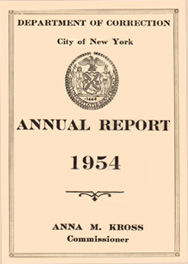
XXX
|
|
From front cover of the 1954 annual report of the NYC Dept. of Correction -- Anna M. Kross' second report as its commissioner.
|
| In her next report, on Page 42 under the subheading "Poultry Farm," the commissioner noted that;
"During 1954 the Department found it unnecessary to purchase poultry from outside sources for the Rikers Island institution, thus reflecting an annual savings of $1,500.
"Since the entire incubation process is being centered at Rikers Island, the poultry project shows an increased from 6000 yo 13,000 chickens on hand. The first shipment of chickens hatched at Rikers Island has been made to the New Hampton Farms Reformatory . . . ."
Page 57 of the 1961 report included a photo of an inmate handing a plant from the Rikers Island gardening project to a Red Cross nurse who had participated as a volunteer in the Blood Donor Program on the island. Page xxxi to Page xxxiii of the same report include the 1961-62 annual report of the Rikers Board of Medication P.S. 616. Among the listed highlights was:
"Greenhouse program . P.S. 616, Bronx, has organized a conservation program with P.S. 43. Bronx, which received favorable mention from the district superintendent and principal."
In connection with this mention of P.S. 616 teaching how to grow and care for plants and flowers, bear in mind that annual reports down through the decades often included lists of civilian job titles and the number employees holding that title. For example, the 1956 report on Page viii listed 4 civilian personnel budget lines for "Institutional Trades Instructor (Farming)" title.
On Page 51 of her 1962 report, Commissioner Kross declared, without elaboration:
"The poultry farm on Rikers Island was discontinued at the end of March, 1962."
The reason for the poultry farm’s discontinuance appears easy enough to deduce from sections in the report detailing the construction underway and planned for the southern end of the island in the farm’s vicinity: C-71 (now known as the Adolescent Reception and Detention Center), C-76 (now known as the Eric M. Taylor Center) and the bridge.
|

